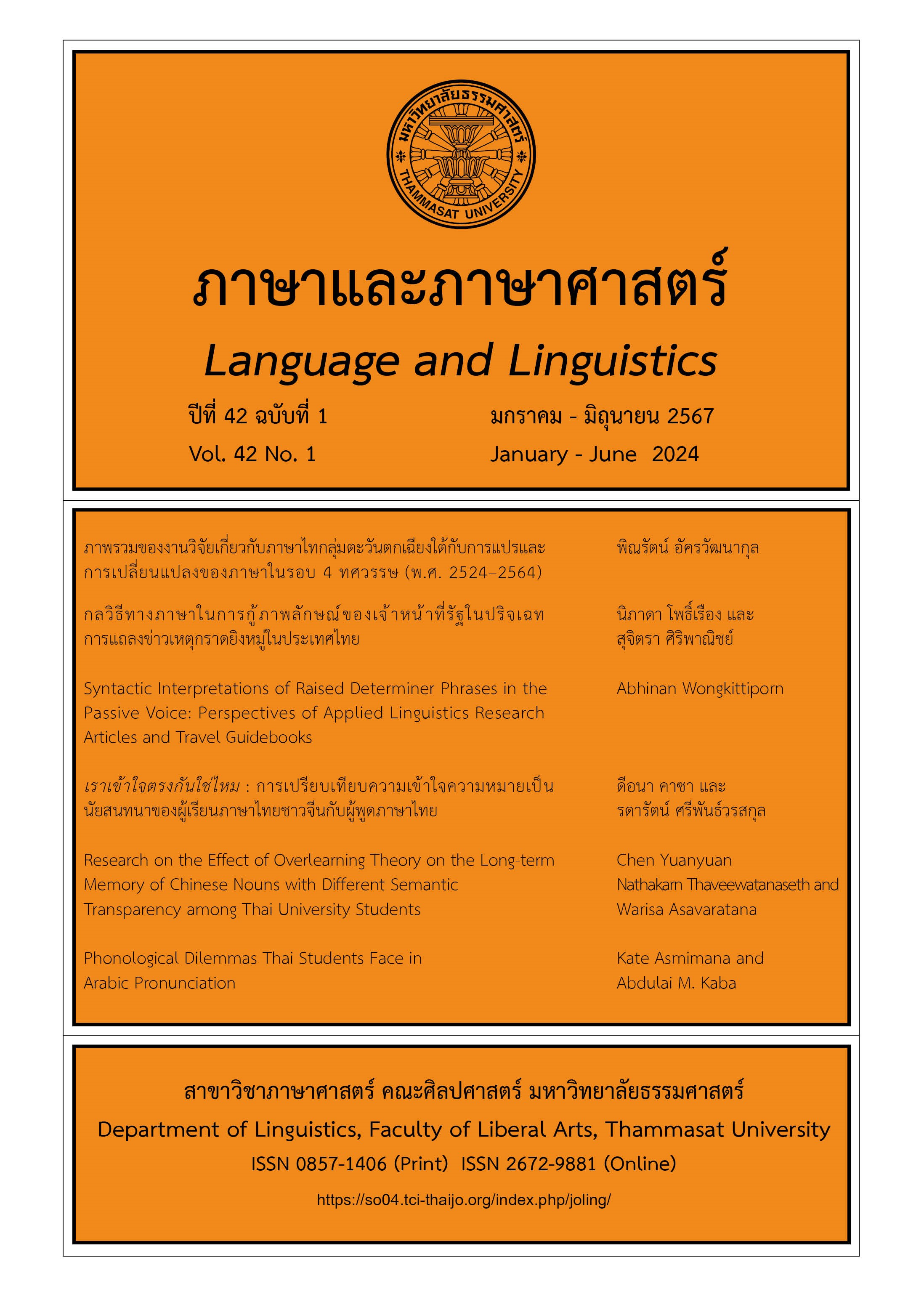Phonological Dilemmas Thai Students Face in Arabic Pronunciation
Main Article Content
Abstract
This study assesses the phonological difficulties Thai students face when pronouncing Arabic consonant sounds by comparing and contrasting Arabic and Thai consonant sounds, and by testing students’ pronunciation issues of Arabic sounds through error analysis (e.g., Corder, 1981; Ellis, 2008). Using a basic random selection method, thirty native Thai-speaking students (18 females, 12 males) took a pronunciation test, giving a demographic introduction in Arabic and then speaking about freedom of expression. Contrastive analysis identified twenty-three Arabic consonant sounds that are absent from Thai, and eleven consonant sounds that are synonymous between Arabic and Thai. To identify mispronounced consonant sounds, an analysis was conducted on the students’ voice recordings. Mispronunciations of some Arabic sounds were common and involved addition, omission, and transformation. The study contributes to the creation of Arabic phonetics curricula in Thai-Arabic language educational institutions.
Article Details

This work is licensed under a Creative Commons Attribution-NonCommercial-NoDerivatives 4.0 International License.
บทความทุกบทความเป็นลิขสิทธิ์ของภาษาและภาษาศาสตร์
References
Corder, S. P. (1967). The significance of learners’ errors. International Review of Applied Linguistics in Language Teaching, 5, 161-170.
Corder, S. P. (1981). Error analysis and interlanguage. Oxford University Press.
Dulay, H., Burt, M., & Krashen, S. D. (1982). Language two. Oxford University Press.
Ellis, R. (2008). The study of second language acquisition (2nd ed.). Oxford University Press.
Gass, S. M., & Selinker, L. (Eds.) (1983). Language transfer in language learning. Newbury House.
Grabe, W. (2002). Dilemmas for the development of second language reading abilities. In J. C. Richards & W. A. Renandya (Eds.), Methodology in language teaching: An anthology of current practice (pp. 276-286). Cambridge University Press. https://doi.org/10.1017/CBO9780511667190.039
Handschin, C. H. (1923). Methods of teaching modern languages. World Book Company.
Haron, S. C., Ahmed, I. H., Mamat, A., Ahmad, W. R. W., & Rawash, F. M. M. (2016). Challenges in learning to speak Arabic. Journal of Education and Practice, 7(24), 80-85.
Hashim, A. (1999). Crosslinguistic influence in the written English of Malay undergraduates. Journal of Modern Languages, 12(1), 59-76.
Khattab, A. (2015). How Arab executives learn [Doctoral dissertation, Michigan State University]. MSU Libraries Digital Collections. https://doi.org/doi:10.25335/wzqw-t320
Lado, R. (1957) Linguistics across cultures: Applied linguistics and language teachers. University of Michigan Press.
Nafi, D. (1995). Asalib iktisab maharatul kalam lighairil natiqin bil arabiyyah fil mustawa al mutawassit fil markaz al I’dadi bil jamiati al islamiyyati al alamiyyati bi maliziya [Master’s thesis]. International Islamic University Malaysia.
Perveen, H., & Dahar, M. A., (2019) Difficulties faced by Students in adopting Arabic language as medium of instruction in International Islamic University Islamabad. International Journal of Innovation in Teaching and Learning (IJITL), 5(2), 91-104.
Richards, J. C., & Sampson, G. P. (1974). The study of learner English. In J. C. Richards (Ed.), Error analysis: Perspective on second language acquisition (pp. 3-18). Newbury House.
Sompong, M. (2014). Error analysis. Thammasat Review, 16(2), 109-127.
Taylor, B. P. (1975). The use of overgeneralization and transfer learning strategies by elementary and intermediate students of ESL. Language Learning, 25(1), 73-107.


